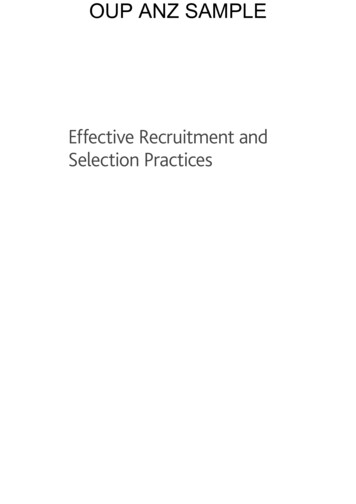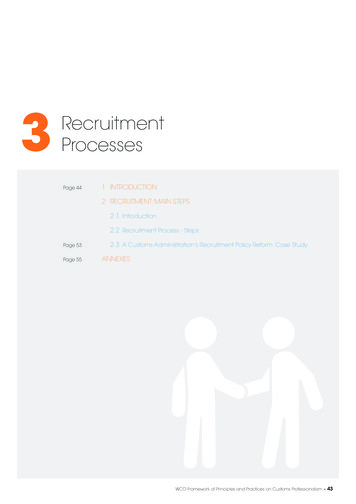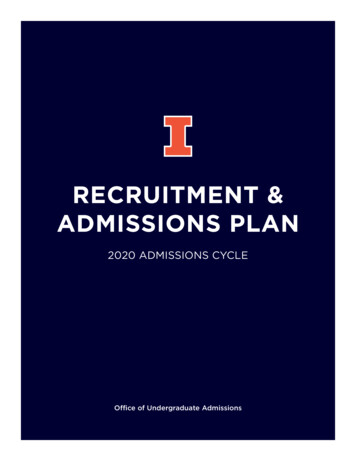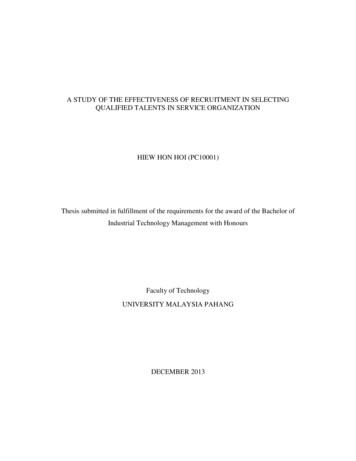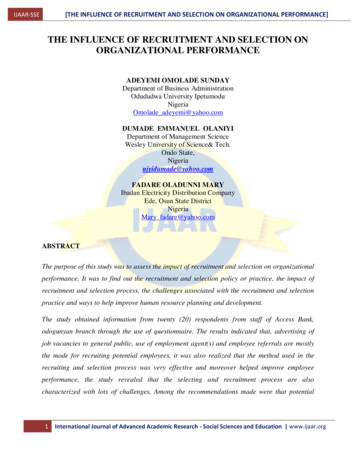
Transcription
CHAPTER - IVRECRUITMENT AND SELECTION PROCESSThis chapter deals with the recruitment and selection process ofsmall and medium scale industries providing the all-importantinformation related recruitment and selection.Recruitment and selection constitutes a staffing function ofmanagement. Scientific selection ensures right man for the right job. Forcreating a team of efficient, capable and loyal employees, proper attentionneeds to be given to scientific selection of managers and other employees.The conventional approach of selecting managers in a casual manner isnow treated as outdated and is being replaced by scientific and rationalapproach, deciding who should hire under the employment rule of theorganisation for the short and long-term interests of the individualemployee and the organisation.1Recruitment and selection is the process of getting humanresources into organizations, departments, sections and jobs use. Whatmight be an even more useful definition of recruitment is that about theart of discovering and procuring potential applicants for actual andanticipated vacancies in the organization. This definition has introducedthe concept of ‘art’ which is about the soft skills of management, some ofwhich might be a natural talent of some managers or acquired throughspecialized training. The use of the word ‘discover’ emphasizes effectiverecruitment, a process that involves exploration which require specializedmethods and techniques, short of which no ‘discovery’ of potentialpeople for the job can be made. Usually, recruitment and selectiondepends on theorganization’s policy guiding recruitment andPage 118
selection.The basic principle in selection is "right man for the right job"and can be achieved only through scientific recruitment and selection.This is because the ability of an organization is determined to a greatextent by the ability of its workforce. The old belief that capital wasfundamental to the progress of the organisation and does not hold goodany longer as employers around the world have begun to believe that asmart workforce is the key to the success of an organization.24.1 RECRUITMENT:Recruitment means an activity which refers to the discovery anddevelopment of workers and employees in the enterprise at the time theyare required. It involves locating, maintaining and contacting the sourcesof man power. The recruitment has been defined by many eminentauthors as under:In the words of Flippo, “Recruitment is the process of searching forprospective employees and stimulating and encouraging them to apply forjobs in the organisation.”3According to Dale Yoder, “Recruitment is a process to discover thesources of manpower to meet the requirement of the staffing schedule andto employ effective measures for attracting that manpower in adequatenumbers to facilitate effective selection of an efficient working force.”4In short recruitment is the process of searching for prospectiveemployees and stimulating them for jobs in the organisation, Thus, therecruitment of employees involves the identification of the sources ofpersonnel, evaluation of different sources available, selection of aparticular source and stimulating the prospective candidates to apply forthe job so that right candidates may be obtained for right job.Page 119
4.2 RECRUITMENT PROCESS:The recruitment and selection is the major function of thehuman resource department. Recruitment process is the first step towardscreating the competitive strength and the strategic advantage for theorganizations. In an ideal recruitment programme, individuals responsiblefor the recruitment process must know how many and what types ofemployees are needed, where and how to look for individuals with theappropriate qualification and interests, what inducements to use or toavoid for various types of applicant groups, how to distinguish applicantswho are unqualified from those who have a reasonable chance of successand how to evaluate their work.5Recruitment process involves asystematic procedure from sourcing the candidates to arranging andconducting the interviews and requires many resources and time. Ageneral recruitment process is as follows:Graph No. 4.1: shows the process of RecruitmentA recruitment policyA recruitment organisationDevelopment of sources ofrecruitmentTechnique used to tapthere sourcesA method of assesing therecuitment programmePage 120
4.3 Characteristics of a Good Recruitment Policy:A good recruitment policy is the guiding can save an organizationfrom facing situations like unproductive test and interview due to nonavailability of the right candidate in the applicant pool, compromising onthe selection of good candidates, high attrition rate low productivity andlow motivation among existing employees as a result of faultypolicy.6The success of an enterprise largely depends upon the ability andefficiency of its employees. To get the capable and efficient employees,the recruitment policy of the organization must be very sound. An idealrecruitment policy must have following characteristics:1. All selections must be made at a central place of the enterprise.2. The whole process of recruitment must be strictly in accordancewith the merit.3. The number of employees to be recruited must be determined wellin advance according to the need of enterprise.4. No such assurance should be given at the time of recruitmentwhich may not be followed later on.5. Higher posts must be filled up through promotions, so far aspossible.6. The qualification experience, terms of service, salaries etc. must bedetermined well in advance.7. The selection of employees must be accordance with the merit.8. The abilities of employees must be according to the need of theirjobs.9. New posts must be authorized by a higher officer.10.Recruitment policy must be fair and flexible.Page 121
4.4 RECRUITMENT PRACTICES IN INDIA:Since 1991, the business environment in India has been dynamicand continuously changing. Business organizations have been growing atvery rapid pace and globalizing. Consequently, organizations are nowlooking for globally competitive workforce. These changing expectationsand requirements have compelled the Indian industrial management tointroduce changes in every sphere of human resource activity, includingrecruitment and selection.7The features of recruitment in India are the following:1. Our industrial labour force consists almost entirely of persons withlittleexperience or no experience of industrial life and work. Theykeep still strong influences the tradition and values of their rural orpre-industrial background. Often the new recruits to the industriallabour force have great difficulty in adjusting themselves to therhythm, discipline and social relationships in the industrialundertaking, and to the new way of life in the community of whichthe undertaking forms a part. Their acceptance of the newenvironment proceeds at a slow pace, and this is often expressedthrough absenteeism, high labour turnover stoppages of work andother facts of protest. Such factors generally become moreimportant when more advanced technology is introduced and newproblem of manpower replacement are created by the higher skillsrequired.2. There is a great disproportion between the number of positionsavailable and the number of aspirants. Sometimes, the ratio is in asmuch as 1:100 or even more. Not only is the expenditure andinconvenience involved in examining a large number of candidatesPage 122
for a few positions great, but also the spectacle of so many personsmaking applications and getting disappointed is a dismal one.Furthermore, the large number of applications that need to beprocessed and the equally large number of candidates who need tobe examined and evaluated is an important source of delays. Onaccount of the present conditions of acute unemployment thechances of incorrect matching of the job and the individual arehigher here than in the developed western countries. The reason forthis is that a man whose choice of employment is very limitedaccepts any job that falls to his lot irrespective of his attitude andsuitability.3. Under the existing statutes dismissal of employees is very difficult,becauseitrequires certain elaborate procedureinvolvingconsiderable time and money to be followed by a manager. Nomanager likes to follow this procedure. This means a person oncerecruited is going to be around longer on any given job and it is notpossible to rely on replacement to improve the quality of the workgroup. The management must count more on utilizing the skills andabilities of the employees that are already present than on replacingthem by more able ones.The above features make systematic manpower planning and will beunderstood, fair and objective criteria for recruitment of specialsignificance to us. But manpower planning has not yet become popularand is practiced only by a few big companies in the public and privatesectors. Public undertakings are believed to be generally overstaffed andhave frequently been criticized by the parliamentary committees for this.In a study, it was found that only 20% of the American subsidiaries and7% of the local firms undertake manpower planning. Those fewcompanies which do undertake manpower planning utilize not onlyPage 123
historical data on manpower but also various forecasting methods toevaluate their future manpower requirements in term of both quantity andquality. A brief description of how Hindustan Lever a private undertakingperforms this function is given below:First, an audit of internal resources is carried out. This indicates thenumber of persons who possess different or higher levels ofresponsibilities. It also reveals the overall deficit or surplus of personnelfor different levels during the planning period.Second, with the help of a detailed organization chart it is determinedthat how many people, at what level, at what positions and with whatkind of experience and training would be needed to meet the businessobjectives during the optimum planning period of 5 years.Finally, taking into account the actual retirements and estimated lossdue to death, ill-health and turnover, based on past experience and futureoutlook in relation to company’s expansion and future growth pattern thefinal figures are arrived at.The planning is done every year for the coming 5 years. Forinstance, a plan is made from the beginning of 1990 to the end of 1994and the next year the plan covers from the beginning of 1991 to the endof 1995. This reduces inaccuracy in forecasting.4.5 SOURCES OF RECRUITMENT:It is essential to organization that develops the different sources ofrecruitment, when the organization is successful in gathering a largeapplication pool, it can adopt a rigorous procedure in choosing the bestemployees without compromising on quality. However, there is no singlecombination of resources and methods that will work well for allorganisation.8Page 124
The various sources of recruitment can be broadly classified into twocategories:A. Internal RecruitmentB. External Recruitment.Most organizations depend upon both the sources. The relative emphasesmay differ from enterprise to enterprise depending upon the followingfactors:1. Training programme of the enterprise whether it prefers trainedpersons or wants fresh candidates to be trained by itself.2. The level of specialization and training required for employees.3. Management policy towards recruitment whether it prefers internalor external sources.4. The need for originality and initiative required from employees.5. Trade union’s attitude towards management’s recruitment policy.Internal Sources: Internal sources of recruitment consist of personnelalready working in the enterprise. Many organizations fill job vacanciesthrough promotions and transfer of existing staff and it also refers tofilling open jobs with the current employees of the organisation. It is aprocess designed to create sufficient interest among the currentemployees to cause them to formally indicate an interest I a givenposition. The position applied for may represent a promotion, transfer oreven demotion in the organisation.9Internal sources: The main sources of internal recruitment are asfollows;1. Present Employee: The most common source of internalrecruitment is through existing employees of organization.Page 125
qualifications to choose employees for suitable vacancies. Theusual method of creating a pool of internal application through jobposting. The evaluate job opportunities relative to their skill,experience, interests and career goal. Promotions and transfersfrom present employees are example of internal sources ofrecruitnement.102. Employees Referrals: It is also a good source of internalrecruitment. Employee develops good prospects for their familiesand friends by acquainting them with the advantages of a job withthe company furnishing letters of introduction and evenencouraging them to apply. This source is an effective source ofrecruiting because many qualified people are reached at a very lowcost to the organisation. A major limitation of employee’s referralsis that the referred individuals are likely to be similar in type tothose who are already working in the organisation.3. Former Employees:Former employees are another internalsource of recruitment. Some retired employees may be willing tocome back to work on a part time basis or recommend someonewho would be interested in working for the company. Sometimespeople who have left the company for some reason or the other arewilling to come back and work. An advantage of this source is thatthe performance of these people is already known.Merits of Internal Sources: Internal recruitment offers the followingadvantages.a) It keeps employees happy and in high morale.b) It creates a sense of security among employee.Page 126
c) Employees know that they stand the chance of promotion tohigher positions. This induces them to work harder so as toprove their worth.d) Internal recruitment ensures continuity of employment andorganizational stability.e) Prospects of transfer to new posts inspire employees to keep onadding to their knowledge and experience which leads to theirdevelopment.f) Filling of vacancies from internal source is quite economicaland convenient. No time and money is to be spent onadvertisement, tests and interview because the knowledge andskill of employees are already known. There is no need fororientation of employees for preparing them for the new job.Demerits of Internal sources: Internal recruitment suffers from thefollowing drawbacks:a) Existing employees may not be fully qualified for the newjob. Required talent may not be available among the presentstaff.b) All vacancies cannot be filled through internal sources. Theenterprise has to depend upon outside sources for entry leveljobs.c) Internal candidates become accustomed to the company’swork patterns and as such may lack originality and freshoutlook. Therefore, internal recruitment involves in breedingof ideas.d) This method narrows the choice and denies the outsiders anopportunity to prove their worth.Page 127
External Sources: The main sources of external recruitment are asfollows;1. Advertising: Advertising in newspapers and journals is themost popular source of recruitment from outside. It is a veryconvenient and economical method for different types rtisement to facilitate self-screening by the candidates. Ifnecessary, the enterprise can keep its identity secret by giving apost box number.2. Educational Institutions: Universities, colleges and institutesof higher education have become a popular source .Management trainees, technicians, etc. Business concerns mayhold campus interviews and select students for final interview attheir offices. Universities and institutes generally run placementbureaus to assist in recruiting students. But educationalinstitutions provide only young and inexperienced candidates.3. Personnel Consultants: A consulting firm is a specializedagency which helps client companies in recruiting personnel. .Itserves as an intermediary between the enterprise and the jobseekers. On a requisition form a client company, it advertisesthe vacancy and receives applications. It may pass on theapplications to the client company or may conduct tests andinterview of the candidates, It charges fee from the clientcompany. This source is generally used for recruitingexecutives.Page 128
4. Jobbers and Contractors: These are sources of recruitment forunskilled and manual labour. They have close links with townsand villages for this purpose.5. Employment Exchanges: Public employment exchanges areimportant sources of recruitment of personnel. Job seekersregister their names with these exchanges. Employers notify jobvacancies to these exchanges that pass on the names of suitablecandidates to the employers.6. Leasing: This method is often used by public sectorsorganizations. Under it personnel from civil services, defenseservices and private sector are employed for specific periodsdue to shortage of managerial personnel.7. Unsolicited Applicants: Due to unemployment problem inIndia business concerns receive a large number of unsolicitedcandidates at the main gate or through mail. Such jobseekersmay be considered for causal vacancies or for preparing awaiting list for future use.Merit of External sources: The main advantages of external recruitmentare as follows:a) Wide choice: The enterprise can choose the best personnelfrom among a large number of applicants.b) Fresh Outlook: Candidates recruited from external sourcesbring originality and fresh viewpoint. They are free from thein-built preferences and prejudices.c) Varies Experience: The enterprise can secure candidateswith varies and broader experience.Page 129
Demerits of External sources: External sources of recruitment have thefollowing disadvantages:a) Danger of Maladjustment: Some candidates chosen fromoutside may fail to adjust themselves to new environment.They may be irritable, quarrelsome or suspicious. They mayhave to be terminated and replaced.b) Expensive: Greater time and money have to be spent onadvertising, tests and interviews of external candidates, costof inductions of new personnel.c) Heart-burning: External recruitment creates heart-burningand demoralization among the existing personnel.d) Sense of Insecurity: Recruitment from outside creates asense of insecurity among the present staff. The staff mayrefuse to co-operate fully with the enterprise.4.6 Principles of Recruitment and Selection:The success of an industrial enterprise depends upon the fact ofwhether the selection has been made properly and according to theprinciples selection or not. In proper selection of best workers andemployees has been made, the enterprise may be successful in achievingits objectives. If proper selection has not been made, the enterprise maynot be successful in achieving it objects. Therefore, the selections in a bigindustrial enterprise must be based on certain principles as follows:1. Clear Policy of Recruitment: The policy of recruitment must bedefinite and clear so that it may be easy to implement the same.2. Observation of Government Rules and Regulations: Beforeformulating the policy of recruitment and selection for theenterprise, Government rules, and regulations of selection must bePage 130
carefully understood and followed, especially with reference to therules of reservation, so that no legal complication may arise at laterstage.3. Policy of recruitment in accordance with the objectsenterprise: The recruitment policy of the enterprise must be inaccordance with the pre-determined objectives of the enterprise sothat it may help in the achievement of objectives lf the enterprise.4. Flexibility: The recruitment policy must be flexible so thatnecessary changes may be made in it accordance to the need of theenterprise.5. Impartiality: The recruitment policy must be such that the fairselection may be assured. Only the best and capable candidatemust be selected on the basis of merit.6. Recruitment by a committee: The right to recruit the workers andemployees must be assigned to a committee of capable, efficient,experienced, senior and responsible officers of the company.Entire work of the process of recruitment must be performed by acommittee and not by any individual officer so that fair selectionmay be assured.7. Opportunity of development to the employee: The selectionpolicy lf the enterprise must be prepared in the manner that it mayprovide challenging opportunities to the employees of theenterprise based on their ability and performance. It will alwayspursue them to do more and better work.8. Job security: Security of job must be assured to every worker andemployee of the enterprise at the enterprise at the time of hisappointment so that he may contribute his efforts to theachievement of organizational objectives.Page 131
4.7 Procedure of Recruitment of Personnel:Recruitment is marketing tool as well as a social relational exercise.While hiring people, the organisations are going out into their outsideenvironment and facing cut throat competition with others for aptcandidates. Therefore, it should be carried out in a manner that retains orincreases the image and goodwill of organisation honest and objectiverecruitment policies and procedures would bring the image of thecompanies into the peak elevation of corporate world.11There must be a definite and well defined procedure for making theselection of employees in the enterprise. The procedure of selection isthe, series of steps through which the employees are finally selected forthe enterprise. The selection procedure must be prepared in the mannerthat more and more information may be made available about thecandidates so that the selection of best employees may be made. Therecannot be any definite selection procedure applicable to all enterprises.However, the common, steps of selection procedure are as follows:1. Acceptance of Application Forms: First of all applications areinvited from the prospective candidates. These applications may beinvited through advertising the vacancies in News Paper,Magazine, Employment Exchange, School and Colleges, TrainingCenters, Labour Unions and other Educational Institutions etc.These applications may be invited on plain paper or on theprescribed forms which may be issued by the enterprise. Thecandidates are advised to give the relevant information in theseapplication forms. These applications provide a record ofqualification, experience etc., of the candidates.Page 132
2. Analysis of Application Forms: A date is declared as the lastsubmitting the application forms. After this date all the applicationsreceived for a post and analyzed in detail. the applications whichare incomplete or which do not meet the requirement of post are setaside and the applicants of remaining applications are furtherinvited for different tests and interviews etc.3. Conducting Employment test: The selected candidates, the basisof their applications are called for employment tests. These testsmay be of the following types:(i) Intelligence Tests: Intelligence tests are meant to measurethe mental ability of an individual in terms of his memory,vocabulary, reasoning etc. these tests measure the power ofunderstanding of the candidates. It is a very common testused in the selection procedure these days.(ii) Personality Tests: Personality tests aim at testing the nature,habit, emotion, maturity and temperament of the candidates.These tests are helpful in deciding the spirit of groupies andfeeling of mutual co-operation.(iii)Aptitude Tests:Aptitude tests are the test whichmeasures the capacity and potentiality for learning the skillsrequired for the job. These tests are very helpful inforecasting the success of candidates on a particular job.(iv)Job Tests: These tests measure the level of efficiencyand skills of the candidates required for a particular job. Forexample, the candidates required for the posts of typist maybe asked to type some material. By this the speed test oftyping and accuracy in typing may be judged.(v) Interest Tests: These are designed to evaluate the likings anddisliking of the candidates for different situations andPage 133
different occupations. These tests are helpful in determiningthe jobs suitable to the individual candidates.Employment tests are becoming very popular device of making theselection of best candidates for different posts. These tests help inmeasuring certain factors of the personality of the candidates.4. Interview: The candidate selected in employment tests are invitedfor interview. The main object of interview is to find out ofwhether an individual candidate is suitable for a particular job ornot. Face to face interview is the most important step of theselection procedure. It helps in judging the personality, ability,capability and the temperament of the candidates. It also providesan opportunity to check the information given by the candidates intheir application forms. It provides the opportunity to the enterpriseto understand the candidates thoroughly. It also provides theopportunity to the candidates to understand the organization andthe job. In this way, it is a process of two way communication.Interview must be conducted in a friendly, congenialatmosphere. Frank free and friendly discussion must be held at theinterview. The atmosphere of the interview must be such that thecandidates may feel easy and may express their ideas and opinionsfreely and frankly. All the questions related to the educationalqualifications, experience, general knowledge, attitude character,health, family background, hobby etc., must be asked thecandidates so that complete information may be obtained aboutthem. On the other hand, complete information must be given tothe candidates about the organization also.Page 134
5. Selection by the Supervisor: Candidates selected in the interviewmust be referred to the supervisor for final selection. If thesupervisor feels satisfied, the candidates are selected. If thesupervisor is a member of the interview board, this step of referringthe candidates to the supervisor is not required.6. Medical Examination: After making the selection of thecandidates they are checked by a reliable doctor or by a board ofdoctors to check their health. The main object of medicalexamination is to check whether the selected candidates arephysically capable or not to perform the required job. Thecandidates which are declared medically unfit are rejected.7. Issue of Appointment Letters: The candidates, who are approvedin the medical examination also, are issued the appointment letters.These appointment letters must contain all the necessaryinformation relating to their posts, period of probation scale, termsof appointment etc. these letters must also mention the date bywhich the candidates should join the firm.8. Arrangement of Training: Necessary arrangements are made forproviding training to the selected candidates, if necessary. Thenature of training and the period of training depend upon the naturejob. Training increasing the efficiency and morale of the selectedcandidates.9. Allotment of Work: When the employees are trained, the work isallotted. The allotment of work must be made keeping in view thecapacity, the ability, the past experience and the taste of candidates.The main point to consider while making the allotment of workmust be the ‘Right man for the right job and right job for the rightman.’Page 135
10.Follow Up: After making the allotment of the work to theemployees, it is followed up. Under this process, the supervisorchecks whether the employees are doing their test work accordingto the instructions issued to them or not. If not, necessaryinstructions and directions are given to them.4.8 Meaning of Selection:Selection is the process of carefully screening the candidates whooffer themselves for appointment so as to choose the most suitablepersons for the jobs that are to be filled. It is the process of matching thequalifications of candidates with the requirements of jobs to be filled. Therecruitment has been defined by many eminent authors as under:In the words of Dale Yoder,“Selection is the process by which candidates are divided into twoclasses-those who will be offered employment and those who will not?”12According to O.Donnell,“Selection is the process of choosing from among the candidates,from within the organization or from the outside, the most suitable personfor the current position or for the future position.”13Selection process divides the candidates into two categories thosewho will be offered employment and those who will not be. This processcould be called ‘rejection’ because more candidates may be turned awaythan hired. It is a process of weeding out unsuitable candidates. It is forthis reasons that selection is often described as a negative process incontrast with the positive nature of recruitment.Page 136
4.9 Significance of Selection:Selection is an important function and it must be performedcarefully. If unsuitable persons are selected, labour absenteeism andturnover will be high. Such persons will shirk their job and ultimatelyleave the enterprise. This will result in wastage of time, energy andmoney spent in hiring and training them. The efficiency of theorganization will go down. The well-being of an organization dependsgreatly on the quality of its managers. Only sound selection of executivescan build up the strong managerial structure of the enterprise. Errors inselection may prove very costly in future.Proper selection is very helpful in building up a suitable workforce.If right people are selected for various jobs, their productivity andefficiency will be high. Therefore, the basic
the recruitment policy of the organization must be very sound. An ideal recruitment policy must have following characteristics: 1. All selections must be made at a central place of the enterprise. 2. The whole process of recruitment must be strictly in accordance with the merit. 3. The number of employees to be recruited must be determined well


